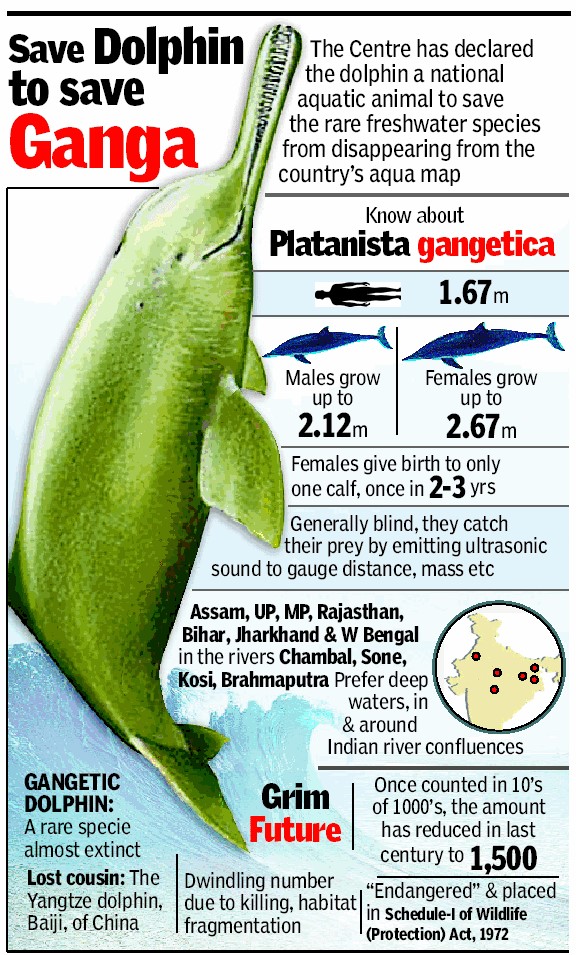- Home
- Prelims
- Mains
- Current Affairs
- Study Materials
- Test Series
Gangetic River Dolphins
A guide for the safe rescue and release of trapped Ganges River Dolphins was released by the Jal Shakti Ministry. The Turtle Survival Alliance''s India Program and Uttar Pradesh''s Environment, Forest and Climate Change Department (EFCCD) collaborated on the document. The guidance is based on the organization''s years of experience rescuing 25 Ganges River Dolphins (GRDs) stranded in irrigation canals.
Since 2010, the GRDs have been designated as India''s National Aquatic Animal, and they are classified as "Endangered" by the IUCN Red List, Schedule I of the Indian Wildlife (Protection) Act (1972), and Appendix I of the Convention on International Trade in Endangered Species of Wild Fauna and Flora (CITES).
The Ganges River Dolphin, commonly known as ''Susu,'' is India''s national aquatic animal. It is one among India''s national symbols. Gangetic Dolphins can be found in Nepal, India, and Bangladesh in the river systems of the Ganga, Brahmaputra, Meghna, and Karnaphuli- Sangu.
The Ganges River Dolphin was designated as India''s National Aquatic Animal in order to safeguard it from extinction. The Ganges Dolphin is also seen as a barometer of the Ganga River''s health. The declaration was made at the first meeting of the National Ganga River Basin Authority (NGRBA) in 2009.
With big flippers and a low triangular dorsal fin, the Ganges river dolphin has a robust yet flexible body. It can weigh up to 150 kilogrammes. The calves are born chocolate brown and mature to a greyish brown colour with smooth, hairless skin. Females have a bigger body size than men. A female''s maximum size is 2.67 m, whereas a male''s maximum size is 2.12 m. Males and females reach sexual maturity at different ages. Females reach sexual maturity at the age of 10-12 years, whereas males mature earlier.
A female gives birth to only one calf once every 2-3 years after a 9-11 month gestation period. Dolphins, along with several turtle, crocodile, and shark species, are among the world''s oldest vertebrates. The Gangetic Dolphins are mostly blind and have a unique way of catching their prey. They make an ultrasonic sound that is picked up by the prey. The dolphin then stores this image in its mind and catches its prey as a result.
In 1801 the Ganges River Dolphin was first discovered.

In 2009, the Indian government designated it as the country''s national aquatic animal.
The Wildlife Protection Act of 1972 makes it illegal to kill a Gangetic River Dolphin.
The Ganges River Dolphin has been classified as ''Endangered'' by the IUCN Red List of Threatened Species.
WWF-India recognized nine segments of eight rivers as excellent habitats for the Ganges river dolphin species, requiring immediate conservation intervention.
The areas include:
• Upper Ganga River (Brijghat to Narora) in Uttar Pradesh (Proposed Ramsar Site) Chambal River in Madhya Pradesh and Uttar Pradesh (up to 10 km downstream of Chambal Wildlife Sanctuary)
• Ghagra and the Gandak River are located in Uttar Pradesh and Bihar, respectively.
• The Ganga River flows through Uttar Pradesh and Bihar, from Varanasi to Patna.
• Bihar''s Kosi River and Son
• Brahmaputra River from Sadia (Arunachal Pradesh''s foothills) to Dhubri (Bangladesh Border)
• The Kulsi River is a tributary of the Brahmaputra River.
Communities around the rivers conduct education and awareness programmes for fishermen and other riparian populations. With the support of the State Forest Department, a strategy and action plan for Ganges river dolphin conservation has been developed for Uttar Pradesh. In addition, a network of partners for Ganges River Dolphin Conservation is established in the country.
Conservation Status
• Indian Wildlife (Protection), Act 1972: Schedule I.
• International Union for the Conservation of Nature (IUCN): Endangered.
• Convention on International Trade in Endangered Species (CITES): Appendix I (most endangered).
• Convention on Migratory Species (CMS): Appendix II
Steps taken by the government
• The International Union for Conservation of Nature has designated the Indus and Ganges River dolphins as ''Endangered'' species (IUCN).
• It is the country''s official aquatic animal, and the government gave it non-human personhood status in 2017.
• The Wildlife Protection Act''s (1972) Schedule I also protects it.
• The Vikramshila Gangetic Dolphin Sanctuary (VGDS) in Bihar is the only Gangetic dolphin sanctuary in India.
• The IUCN has classified it as endangered on the Red List of Threatened Species.
• Project Dolphin: In his Independence Day Speech 2020, the Prime Minister announced the government''s plans to launch a Project Dolphin. It will be similar to Project Tiger, which has aided in the increase of tiger populations.
• The Ganges River Dolphin Conservation Action Plan 2010-2020 "identified threats to Gangetic Dolphins and the impact of river traffic, irrigation canals, and depletion of prey-base on Dolphin populations," according to the plan.
• National Ganga River Dolphin Day is observed on the 5th of October by the National Mission for the Clean Ganga.









 Latest News
Latest News
 General Studies
General Studies